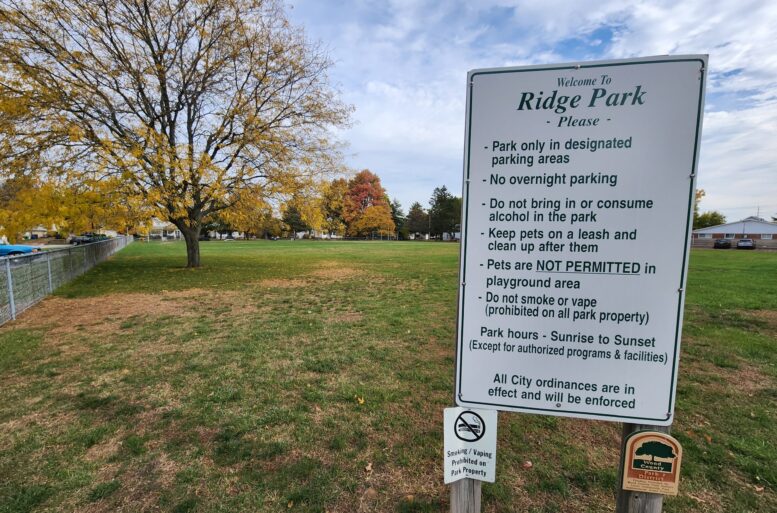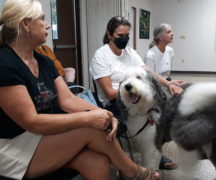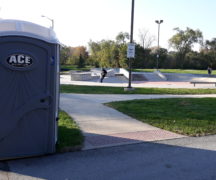By JAN LARSON McLAUGHLIN
BG Independent News
A middle ground – figuratively and literally – is being sought for a new dog park in Bowling Green.
On one side of the issue are dog owners who would like a dog park within walking distance from their homes, unlike the county’s dog park east of Interstate 75.
On the other side is the city’s park department, which does not have park land it would like to repurpose for a dog park, nor does it want already stretched staff to get saddled with the maintenance of a dog park.
The dog park advocates, Citizens for BG Dog Parks Committee, have agreed to some stipulations by the city. At the urging of city officials, the group had a feasibility study done on dog parks, has held several fundraisers, has agreed to create a non-profit organization to lease land for a dog park, and has agreed to maintain the site.
Proponents of a new dog park feel they have been jumping through hoops with little progress to show for it.
City officials have acknowledged that progress has been slow, but say they want to get this right.
Of the three city sites examined in the feasibility study, it appears that a portion of Ridge Park is the most likely location.
Like a dog with a bone
A “walkable” dog park in Bowling Green is not a new topic. City Council member Bill Herald brought the idea to the BG Parks and Recreation Board during a meeting in August 2019.
Herald told the board that he had heard from a number of residents interested in a city dog park. He asked that the issue be placed on the park board’s agenda at its strategic planning and that the possibility for a dog park be studied at the same time as the park master plan update.
A citizens group was formed and has been doggedly pursuing the dog park concept. Citizens have repeatedly taken their case to City Council and the Parks and Recreation Board. They have held several fundraisers to help their cause, and picked up more citizen support along the way.
While the parks board did not include a dog park in its master plan update, City Council took the unusual action of adding it for the board. In addition, council voted to earmark $150,000 in American Rescue Plan Act funds for a dog park.
Founding members of the citizens’ group, Raul and Jo Ascunce expressed frustration this week about little progress being made in the last 18 months. They feel the city keeps adding more obstacles to the proposal – and the organization is like a dog chasing its tail.
“We’re frustrated that our efforts have not met the criterion for the city to move forward more quickly,” Jo Ascunce said.
The feasibility study, conducted by a graduate class at Bowling Green State University, was completed last December but has not been discussed during meetings of City Council or the Parks and Recreation Board.
The study, according to BG Parks and Recreation Director Kristin Otley, didn’t really provide any new information for the city.
“We don’t really see any place in city parks that isn’t being used.” And the staff is already at capacity, she added.
During discussions with city administration, the possible locations were narrowed down to Ridge Park. The newer park, located where Ridge Elementary used to sit, has a playground on the south end and a big open area on the northern portion.
“Of all the city properties, that would be the most likely,” Otley said.
In order to not put further burden on existing parks and recreation staff, discussions have also been held on leasing the land to the citizens group and tasking them with maintenance responsibilities.
“That’s one of the things we’re in conversations about,” Otley said.
Rose Drain, of the citizens organization, said the group has agreed to lease park space from the city and manage the dog park.
“Progress was stalled. We’re hoping to start talking about some details soon,” Drain said. “It’s a work in progress.”
Wheels move slowly
Otley encouraged continued patience in the process.
“Sometimes in municipal government things don’t move as fast as in private,” she said. “Nothing is simple, there’s lots to consider. It’s more than having a fence and letting dogs off leash.”
Herald said Otley has done a good job of wading through the dog park issue that has strong feelings on both sides.
“I’m impressed with Kristin. She’s in a tough spot,” trying to be responsive to dog park advocates and to city government.
City Council member Jeff Dennis is a member of the Citizens for BG Dog Parks Committee.
“I can see both sides of it,” he said. “I’m frustrated with the speed that government moves generally.”
In this case, the city has to consider the liability and maintenance of a dog park, he said. Discussions are taking place with the city administration and law director.
“They are making sure everybody is aware of their responsibilities,” Dennis said. “I think things are moving, they’re just moving slowly.”
Mayor Mike Aspacher said he has met several times with members of the dog park organization, and said the topic is part of an “ongoing discussion.”
“I’ve had concerns about the park department’s ability to take on more responsibility,” he said, noting the parks are primarily funded through a levy. “A dog park will require a good deal of maintenance and operations oversight.”
Aspacher explained a lease of park land for a dog park would work similar to the existing leases for Carter Park baseball and for Country Club golf.
Dennis pointed out that before a dog park is built, the city will have to meet with neighbors to make them aware of the plans, get their input, and show renderings of the plan if possible.
Feasibility study
The purpose of the study conducted last year was to determine the feasibility of building another dog park in Bowling Green that will be closer and more accessible for people and their dogs to use.
This study examined practices of other dog parks in cities of relative size, management structures, a budgetary analysis of the costs to build and maintain the dog park, as well as an assessment of possible dog park locations.
When creating a dog park, some of the important considerations include noise, amenities for dogs and humans, waste disposal systems, minimum space requirements and maintenance of the facilities.
Research was done on existing dog parks in towns similar to Bowling Green, to see what elements can make a dog park successful. The study also looked at multiple ways to maintain the dog park, using city staff, volunteers or interns.
Additionally, this feasibility study also covered different potential locations where the dog park could be built, including the pros and cons for each location.
The study also examined the minimum price tag for a dog park. Including different amenities and equipment, the minimum cost for a one-acre dog park was estimated at $69,000.
This project was completed under the supervision of Dr. Shannon Orr at BGSU as part of a class project in the Master of Public Administration program. Following are some of the findings.
Noise
The noise within dog parks can reach levels that are slightly louder than traffic. It is recommended that the dog park be placed at a minimum of 50 feet from residential areas, and preferably at least 150 to 200 feet away from homes.
Amenities
Physical amenities such as shade structures, benches and dog play structures are options.
Waste disposal
Waste disposal is a large part of the maintenance of a dog park. Typical parks have at least two pet waste stations, which can usually cost around $200 each. Having signage reminding community members to use these stations, and having disposable bag dispensers could be helpful. A reported 40% of visitors will not clean up waste, according to a 2018 study done by the National Recreation and Park Association.
Upkeep and maintenance
The study looked at options such as placing the parks and recreation department entirely in charge of the upkeep of the park, having volunteers assist, or enlisting the help of a campus volunteer organization.
Locations
Dog parks generally require at least a half-acre of land. Most dog parks are in a relatively central location, making them accessible to walkers. The study used a rubric to rank potential locations in the city, rating each site for size, parking availability, land suitability, shade, water source and accessibility.
The study looked at three potential locations for a dog park, including the Arboretum west of the Pearl Street Fire station, Ridge Park, and Conneaut Haskins Park.
Arboretum
- Strengths: The large space spans approximately four acres; nearby residencies are outside best practice recommended guidelines; it is walkable (under one mile) distance for 6,900 Bowling Green residents; it is close to businesses.
- Weaknesses: Limited shade; no parking.
Conneaut Haskins Park
- Strengths: Already has an existing buffer; has existing parking; a large portion is underutilized; already maintained by city.
- Weaknesses: Within 110 feet of nearby residences; would be a smaller option.
Ridge Park
- Strengths: Existing fence; existing parking; already maintained by city; walkable (within one mile) for 14,000 Bowling Green residents.
- Weakness: Within 110 feet of nearby residences.
Common policies
Policies can help dog parks run smoothly. The study looked at a combination of the policies taken from the operating dog parks in other Ohio communities:
• Dogs must be registered and up to date on all vaccinations
• Dogs must be under reasonable control by the owner at all times
• When outside the perimeter of the park, dogs must be leashed
• Dog owners must clean up after their dogs (penalties may incentivize this rule)
• Only registered owners and handlers allowed within the park
• No food allowed within the park
• No dogs in heat
• No aggressive dogs
• Dogs under the age of 4 months are not permitted to enter
• No glass containers
• The dog park is for dogs and humans only
• Smoking is prohibited while inside the fence of the dog park
• Usage of the dog park comes at your own risk
• Owners are legally responsible for their dogs at all times
• Dog handlers must be 18 or older
• Children under the age of 16 must be accompanied by an adult at all times
Cost Analysis
The analysis assumes the size of the dog park to be one acre, as that is the recommended size.
Surface
Preliminary research showed that natural grass, size permitting, may be the most affordable option for the ground cover of the dog park. Using turf would mean that the dog park surface stays green all year round, but it is more costly and needs to be regularly cleaned and replaced after a certain number of years.
If the dog park surface is natural grass, the costs associated with that include mowing, fertilization and weed control.
Fencing
The recommended fence height for a dog park is 4 to 6 feet. For a one-acre dog park, 834.34 feet of fencing is needed. The total fencing cost for the park will be around $25,000, based on estimates from building supply stores.
Agility Equipment
Included in this budgetary analysis are a few options for agility equipment, with costs estimated between $8,000 and $10,000.
Costs
- Grass (mowing and upkeep) – 1 acre, around $6,000 a year
- Fencing – $25,000
- Agility equipment – $8,000
- Water fountains – two for $10,000
- Benches – six for $3,000
- Waste disposal stations – four for $2,000
- Signage – $1,000
- Shade Shelter – two for $20,000
- Total (not including grass costs) – $69,000
Operations
The study looked at the strengths and weaknesses of different forms of operations.
City owned and operated
- Strengths: Well funded due to COVID relief funds; well maintained and operated if run by the parks and recreation department; city could potentially use the dog parks as a small revenue source.
- Weaknesses: The Parks and Rec department would likely have to bring on additional or seasonal help to effectively maintain and operate the dog park.
Non-Profit Partnership
- Strengths: A partnership would allow for the city and potential partner to share some of the operating and maintenance costs; parks and rec would have a limited role (if any) in the daily operation of the dog park.
- Weakness: Dog parks are often left unsupervised when being operated by a non-profit due to a lack of funding, staff or volunteers
For the feasibility study, the students analyzed more than 23 different dog parks in Ohio and multiple dog park feasibility studies. The dog parks studied were mostly in the northeastern portion of Ohio. They were Brunswick, Lakewood, Memorial, Akron, Bow Wow Beach, Avon Lake, Sunny Lake, Orville, Canal Fulton, Schellin, Furnas, Mentor, Schneider Community, Fairport Harbor Lakefront, Mosquito, Gambier, Wolf Run, Carrolyn Ludwig, Taps and Tails, Hilltop, Tri-City, Canning Family, and Downtown Dog Park.





